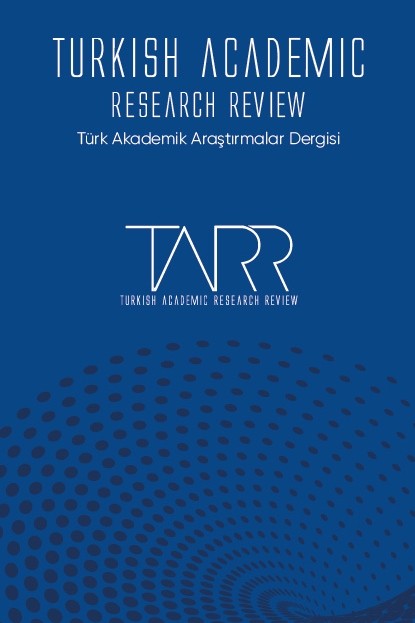Eugène Ionesco’nun Gergedanlar Oyununda Gergedanlaşma
Eugène Ionesco’nun 1959 tarihli Gergedanlar adlı oyunu, eser boyunca baskın ideolojinin etkisi ile karakterlerin gerçek ve metaforik anlamlarda gergedanlara dönüşme sürecini aktarmaktadır. Ionesco’nun metni, baskın düşünce yapısının bir parçası olmaya direnen ana karakter Berenger’in mücadelesi aracılığıyla manipülatif bir ideolojiye körü körüne bağlanmaktan ziyade bireyselliğin ve bireysel özellikleri korumanın önemini vurgulamakta ve tartışmaktadır. Ana karakter Berenger, düşünce farklılığını ve zenginliğini hoş görmeyen baskın ideolojiyi benimseyen diğer karakterlerden bu anlamda farklıdır. Eser boyunca, daha fazla karakter gergedanlara dönüştükçe, Berenger’in yalnızlık hissi de bu duruma bağlı olarak artmaktadır. Böylesi bir durum, adı geçen karakterin toplumundan daha çok soyutlanmasına ve uzaklaşmasına neden olmaktadır. Bu bağlamda, bu çalışmada öncelikle absürt tiyatro hakkında konu ile alakalı kısa bilgi verilecek, daha sonra Eugène Ionesco bir oyun yazarı olarak kısaca tanıtılacak ve sonuç olarak karakterlerin gergedanlara dönüşme süreci ele alınacaktır. Bireyselliğin aşamalı olarak kaybı anlamına gelen bu süreç, birincil kaynağa ve konu ile alakalı ikincil kaynaklara yapılan göndermeler üzerinden ortaya konacaktır.
Anahtar Kelimeler:
Gergedanlar, Gergedanlaşma, Dönüşüm, Absürt Tiyatro, Eugène Ionesco
Rhinocerisation Process in Rhinoceros by Eugène Ionesco
Rhinoceros by Eugène Ionesco (1959) presents the gradual literal and metaphorical transformation process of characters into rhinoceroses under the strong influence of the dominant ideology throughout the play. Ionesco’s play discusses and highlights the significance of maintaining one’s own individuality instead of mere adherence to a manipulative ideology through the struggle of the main character, Berenger. Berenger is in this respect different than other characters who adopt the represented ideology that does not tolerate plurality and diversity of opinions. The more characters turn into rhinoceroses, the stronger Berenger’s feeling of solitude and loneliness gets, which increases his alienation from his society. This study will in this regard give brief relevant information about the Theatre of the Absurd; then briefly introduce Eugène Ionesco as a playwright; and finally discuss the literal and metaphorical transformation process of the characters into rhinoceroses, which stands for the gradual loss of their individuality with specific references from the primary source and relevant secondary sources.
Keywords:
Rhinoceros, Rhinocerisation, Transformation, Theatre of the Absurd, Eugène Ionesco,
___
- Craddock, George E., Jr. (1971). Escape and Fulfilment in the Theatre of Eugène Ionesco. The Southern Quarterly, 10, 15-22.
- Dolamore, C. E. J. (1984). Ionesco: “Rhinoceros”: Critical Guides to French Texts S. London: Grant & Cutler Ltd.
- Ekberg, Jeremy (2011). Ontological Empowerment: Embodiment and Essence in the Theatre of the Absurd. Unpublished doctoral dissertation. The University of Alabama, Tuscaloosa.
- Esslin, Martin (1960). The Theatre of the Absurd. The Tulane Drama Review, 4(4), 3-15. Doi:10.2307/1124873
- Esslin, Martin (2001). The Theatre of the Absurd. 3rd. Ed. New York: Vintage Books.
- Fowlie, Wallace (1960). New Plays of Ionesco and Genet. The Tulane Drama Review, 5(1), 43-48. Doi:10.2307/1124901
- Guppy, Shusha (1984). Eugène Ionesco: The Art of the Theater no. 6: Interviewed by Shusha Guppy. The Paris Review, 93. https://www.theparisreview.org/interviews/2956/the-art-of-theater-no-6-eugene-ionesco
- Haney, William S. II. (2008). Eugène Ionesco’s Rhinoceros: Defiance vs. Conformity. Interactions. 17(1), 85-101.
- Ionesco, Eugène (1960). Rhinoceros. Rhinoceros and Other Plays. Trans. Derek Prouse. New York: Grove.
- Lane, Nancy (1994). Understanding Eugène Ionesco. Columbia: University of South Carolina Press.
- Morgan, Margot Bonel (2010). The Decline of Political Theatre in 20th Century Europe: Shaw, Brecht, Sartre, and Ionesco Compared. Unpublished Doctoral Dissertation. The State University of New Jersey, Rutgers.
- Murray, Jack (1962). Ionesco and the Mechanics of Memory. Yale French Studies, 29, 82-87. Doi:10.2307/2929038
- Quinney, A. (2007). Excess and Identity: The Franco-Romanian lonesco Combats Rhinoceritis. South Central Review, 24(3), 36-52. http://www.jstor.org/stable/40040007
- Strem, George G. (1962). Ritual and Poetry in Eugène Ionesco’s Theatre. Texas Quarterly, 5(4), 149-158.
- Valentine, John M. (2011). Kitsch and the Absurd in Eugène Ionesco’s Rhinoceros. Florida Philosophical Review, 11(1), 54-65.
- Thomson, Peter. (1970). Games and Plays: An Approach to Ionesco. Educational Theatre Journal, 22(1), 60-70. Doi:10.2307/3205501
- Williams, Edwin T. (1962). Cervantes and Ionesco and Dramatic Fantasy. Hispania, 45(4), 675-678. Doi:10.2307/337349
- Yayın Aralığı: Yılda 4 Sayı
- Başlangıç: 2016
- Yayıncı: Mehmet ŞAHİN
Sayıdaki Diğer Makaleler
Otobiyografik Bir Roman Örneği Olarak Eylülün Kızgın Soluğu
Eugène Ionesco’nun Gergedanlar Oyununda Gergedanlaşma
Grice’in Teorisi Açısından Kamûs-ı Keşânî Destânı’nın İncelemesi
Mezhebî Aidiyetler Bağlamında Mu‘tezile’nin Arap Dilini Kullanımı
Cezaî Sorumluluk Bağlamında İkrah ve Hukuki Sonuçları
Manzum Bir Osmanlı Kroniği Olan Silkü’l-Le’âl-i Âl-i Osmân’ın Kaynakları
Yetişkinlerde Dindarlık ve Psikolojik Dayanıklılık İlişkisi
J.G. Ballard’ın The Drowned World Romanının Ekofeminist Okuması
